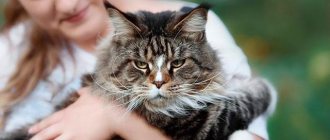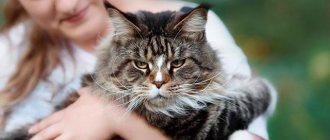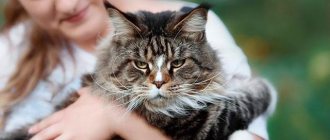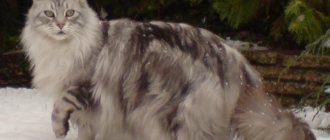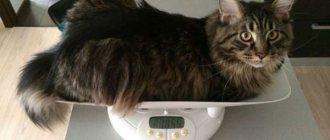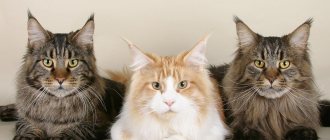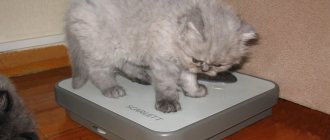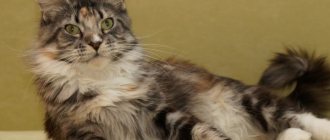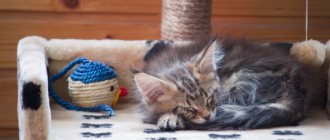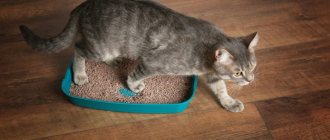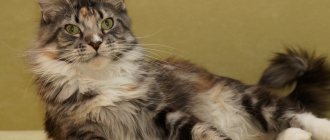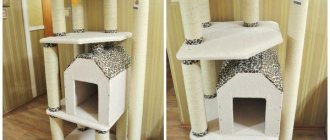Record holders among Maine Coons
Among the currently registered record holders, the largest domestic cats are representatives of the American elite breed Maine Coon . Such a pet is not one of the publicly available breeds, since its acquisition and maintenance are quite expensive.
Charming Maine Coons were bred by experienced breeders just over two centuries ago, and the natural conditions in the region where the work was carried out made it possible to obtain an animal with thick and very long hair. As a result, cats and cats of this breed are not only excellently adapted to harsh weather and can easily withstand frost, but also have an original appearance and impressive, large size.
This is interesting! In the course of strengthening and improving the main breed characteristics of the Maine raccoon cat, it was possible to breed a large animal with an original exterior.
The most famous record holder of the Maine Coon breed is the longest and largest cat in the world named Sweetie, originally from Nevada. The body length of this cat from the tip of the nose to the tail is 1 meter 23 cm 2 mm. The record was officially registered, and the owner of the champion characterizes her pet as a very kind and affectionate cat.
Before the cat Stewie, the record holder was also a representative of the Maine Coon breed, whose weight at the age of five exceeded fifteen kilograms, and the length of his tail was 41.5 cm. No less famous was the Finnish Coon named Missy, who had whiskers or whiskers 19.0 long cm.
The record holder was also the mixed-breed cat Velvet, whose age three years ago was a quarter of a century. However, as practice shows, the average life expectancy of representatives of this breed rarely exceeds twelve years.
Maine Coon adult size
The world's largest breed, the Maine Coon, is surrounded by many myths and stories that also relate to the size of these animals. However, the average weight of an adult and fully developed male Maine Coon Cat ranges from 5.9-8.2 kg, and the body weight of a female ranges from 3.6-5.4 kg.
The height of an adult Maine Coon, as a rule, does not exceed 25-41 cm, with a total body length with tail of up to 100-120 cm . The maximum length of the tail of the average representative of the Maine raccoon cat breed most often does not exceed 35-36 cm. The Maine raccoon cat reaches its full size at the age of three to five years, which is quite late compared to other popular and widespread breeds.
This is interesting! Thoroughbred animals, when gaining a body weight of 8-9 kg, look much larger and more massive, which is due to the characteristic exterior, represented by an elongated and elongated body with large and well-developed muscles, strong limbs, as well as a massive neck, head and shoulders.
Maine Coon kitten size
Maine raccoon cats are born quite large in size and weigh an order of magnitude more than kittens of other breeds. For example, if the weight of a newborn Persian breed varies between 125-150 g, then a Maine Coon kitten is born weighing 125-170 g. According to average statistical data, the weight of a newborn Maine Coon is significantly influenced by the number of kittens in the litter, therefore , the fewer kittens, the greater their weight.
The rate of growth processes and weight gain in a newborn directly depends on its gender, as well as the characteristics of the parental genotype. As a rule, kittens born from a physically healthy and massive cat grow and develop faster. The kitten's growth can be negatively affected by the cat's use of hormonal drugs that can provoke a pronounced endocrine imbalance.
In order for a Maine Coon kitten to gain height and weight correctly, it is necessary to comply with a number of requirements, including ensuring optimal sanitary and hygienic conditions in the place where the animals live, preventing stressful situations in the form of noise and temperature changes, and proper and balanced nutrition for the nursing cat and kittens.
Important! remember that the daily rate of weight gain for a healthy newborn Maine Coon should be about 10-11 grams.
The suckling period lasts from birth until four weeks, and is also characterized by constant and stable growth. In the first ten days, the kitten’s body weight doubles, and by a month the weight becomes approximately four times greater.
Puberty
Due to their large size, Maine Coons are believed to take a long time to develop and become fully mature by the age of three. However, this depends on the individual characteristics of the animal. On average, puberty occurs between the 6th and 15th months of a pet's life.
Before the onset of puberty, Maine Coons are almost completely formed. The bulk has already been recruited. So, at six months, males weigh up to 6 kilograms, females - up to 5. Then only the animal enlarges. The weight finally stabilizes by the age of one and a half years and ranges from 7 to 8 kilograms in males, and from 6.5 to 7 kilograms in cats.
Maine Coons are massive cats. However, their appearance is deceiving: the real weight of pets is half as much as it seems.
Not a single representative of the breed has yet crossed the 10 kilogram bar (even with signs of obesity). Although the average weight of cats is 7.5 kg, it often exceeds the threshold of 8 kg. And the impressive appearance of Maine Coons has given them a reputation as giants among domestic cats.
Important: There are lighter Maine Coons. The weight of a particular pet depends on its individual characteristics. The lower threshold for males is 6 kilograms, for females – 4.5 kilograms. At the same time, the size of the animal does not genetically depend on the physique of the parents: in graceful cats, the adult offspring can be quite large and vice versa.
Source
Weight table by age
The development of the animal occurs quite evenly, but a jump in growth processes, as a rule, occurs in the fourth or fifth month of a pet’s life:
| Age | Male weight | Female weight |
| a week | 240-280 g | 240-260 g |
| two weeks | 250-350 g | 300-400 g |
| month | 630-820 g | 560-740 g |
| two month | 1.23-1.50 kg | 1.1-1.4 kg |
| three months | 1.8-2.3 kg | 1.7-2.3 kg |
| four months | 3.0-3.8 kg | 2.7-3.6 kg |
| five months | 3.2-5.5 kg | 2.9-4.3 kg |
| six months | 3.5-5.8 kg | 3.0-4.5 kg |
| seven months | 4.2-6.5 kg | 3.5-4.9 kg |
| eight months | 4.4-6.8 kg | 3.8-5.2 kg |
| nine month | 5.1-7.2 kg | 4.1-5.5 kg |
| ten months | 5.3-7.6 kg | 4.2-5.8 kg |
| eleven months | 5.6-8.1 kg | 4.3-6.1 kg |
| twelve months | 5.7-9.0 kg | 4.5-6.8 kg |
| one and half year | 6.0-9.5 kg | 4.5-7.0 kg |
| two years | 10.0 kg | 4.7-7.3 kg |
| two and a half years | 12.0 kg | 7.5 kg |
| three years | 13.0-16.0 kg | 7.5-8.0 kg |
Mass table by month
| Kitten age | Cat weight (in grams) | Cat weight (in grams) |
| 1 month | 630 - 750 g | 560 - 680 g |
| 2 months | 1230 - 1500 g | 1150 - 1400 g |
| 3 | 1800 - 2300 g | 1700 - 2300 g |
| 4 | 3000 - 3800 g | 2700 - 3600 g |
| 5 months | 3200 - 5500 g | 2900 - 3900 g |
| 6 | 3900 - 6500 g | 3200 - 4000 g |
| 7 | 4200 - 6500 g | 3500 - 4300 g |
| 8 | 4500 - 6900 g | 3800 - 4300 g |
| 9 | 5000 - 7000 g | 4100 - 5000 g |
| 10 | 5200 - 7500 g | 4200 - 5500 g |
| 11 | 5700 - 8000 g | 4300 - 6000 g |
| 1 year | 5700 - 9000 g | 4500 - 6300 g |
| 1.5 years | 6000 - 9500 g | 4500 - 6500 g |
| 2 years | up to 10,000 g | 4500 - 7000 g |
| 2,5 | up to 12,000 g* | 4500 - 7200 g |
| 3 | up to 13,000 g* | up to 7500 g |
* Up to 12,000 - 13,000 g - the weight of adult castrated cats.
How does the size of a cat and a cat differ?
Maine Coon cats develop more slowly compared to males, and their maximum weight at full development does not exceed 7.3-7.5 kg . Males, which are representatives of the Maine coon cat, are noticeably larger than cats, and the average body weight of an adult neutered animal reaches 12-13 kg.
However, when observing the growth and development of such a pet, it is necessary to take into account the fact that a cat at the age of two cannot weigh more than 10 kg. Such excess body weight may indicate metabolic disorders, heart problems or joint pathologies, so it is necessary to consult a veterinarian. Despite their impressive size, Maine Coon cats do not have problems with obesity at all.
Animal care
You need to be especially attentive to the Maine Coon in the first few months of his life. It is then that the kitten’s character and habits are formed.
For example, it is important to pay special attention to feeding. Since the breed is not cheap (the estimated price of such fluffy happiness starts at $500), then any kind of food will not be suitable here.
© shutterstock
It is important to note that the diet of a Maine Coon cat differs from month to month. Although this is a hunting breed, babies should be given liquid food and pureed food . Meat will not hurt, but in a ground form. In addition, you can please your baby with natural milk.
We figured out what and how to feed a Maine Coon kitten at three months, but with an adult cat it’s already easier. From about 4 months, you can begin to introduce food into your pet’s diet and add variety to its diet.
At 3 months the weight is already about 2 kg.
Height depends on the length of the fluffy's paws and is most often individual for each kitten. Although often these kittens already look like an adult domestic cat in size.
At one year old, your pet can already eat whatever its owner offers it. It is recommended to give your pet not only super-premium and holistic-class dry food (the quality is as close as possible to natural food), but also to pamper your pet with meat and homemade food (without excessive use of seasonings, of course). Although their food is expensive, even considering their size, representatives of this breed do not eat too much.
What affects the growth of Maine Coons
The growth of the Maine Coon Cat is directly influenced by many internal and external factors . The first category includes determined breed characteristics. Also, as the animal grows older, there is a clearly visible difference in the rate of weight gain in males and females, as a result of which cats become significantly heavier than females by the age of three months.
The category of internal factors includes the body weight of the mother and the genotypic characteristics of the parents - when the parental genotypes are combined, an organism with unique parameters appears with special development of the skeleton and muscular system.
The most significant external factors influencing the growth of the Maine Coon are presented:
- compliance with sanitary and hygienic standards when keeping a cat and its offspring;
- the presence or absence of stress factors or unfavorable conditions;
- quality food characteristics.
Some individual factors that do not belong to the category of external or internal parameters can also affect the growth and weight gain of an animal.
Deviations from the norm
Insufficient weight gain and decreased body weight are allowed only during the initial stage of growth, during the first week of life. At the neonatal stage, weight gain and height depend on the characteristics of labor.
This is interesting! In the first four days, even minor weight loss is allowed, which is steadily restored in the coming days.
If an animal whose age is more than a couple of months loses weight, then it is necessary:
- introduce more high-calorie foods into the diet;
- make a competent change in diet;
- supplement the diet with a vitamin-mineral complex;
- use dietary supplements in feeding that stimulate the appetite, as well as quickly normalize the functioning of the stomach and intestinal tract.
It should be noted that at three to four weeks the kitten’s body weight may gradually decrease, which is explained by the transition of the pet from mother’s milk to solid food. And starting from seven weeks, the animal’s weight gains again.
Important! Solid, complete diets with beneficial microelements, vitamins and minerals promote weight gain.
The owner of a Maine Coon should be wary not only of the pet’s underweight, but also of the pet’s excessive body weight . If necessary, you should consult with veterinary specialists who can correctly determine the cause of deviations from the normal weight and height of the Maine raccoon cat.
Kitten development
During its maturation, a growing kitten goes through four stages of growth:
- Neonatal period. This is also the period of the newborn. It usually lasts 4 days. During this time, the daily weight gain of the cat's cubs depends on how easy their mother's birth was.
- Suction period. Lasts 1 month. During this time, kittens, on average, gain from 20 to 50 grams of weight daily.
- Transition period. It begins from the time the cat cubs begin to eat a little on their own and continues until about one and a half to two months (7-8 weeks of life). At this time, the rate of weight gain slows down somewhat.
- After the suckling period. The kittens are weaned from their mother, the cat, and feed completely on their own. They begin to gain weight and height again quite quickly. This stage lasts from approximately one and a half months until the little Maine Coon becomes a full adult.
Cats of this breed mature and gain weight until about the age of three.
They also grow up to the age of 3 years. It is during this period that physiological and psychological maturation occurs, as well as puberty. For about another year or two the cat will continue to “matrate.” Muscle mass will increase, he may gain a little weight, and his chest will expand. At the age of 4–5 years they are active and full of energy.
General size statistics for Maine Coons
A newborn baby often does not predict the large size of an adult. The body length of Maine Coons at birth is about 12 cm. They weigh from 100 to 150 grams . These are very standard parameters for kittens of all breeds. However, over time, the Maine Coon becomes longer, gaining muscle mass. And this happens quite quickly.
The length of the Maine Coon cat increases at a tremendous speed over the months, so nurseries do not even undertake to display any statistics. Much depends on the individual. Some cats grow faster, some more moderately. What can we say if sometimes the length of a Maine Coon cat at 5 months reaches half a meter .
First month
The first month is the most important period in the life of a little Maine Coon. Every day he must gain a certain amount of weight: in the first days - up to 10 g, in the second or third week - from 20 to 50 g.
By the end of the fourth week, the weight of males ranges from 620 to 750 g, females - from 520 to 650 g.
Important: The weight of newborn kittens does not depend on gender. Males and cats should have approximately the same weight. If your pet's weight is too low, it indicates health problems.
What affects the sizes
The size of a Maine Coon kitten does not always correspond to the norm. The fact is that the growth of any pet very much depends on several factors that can significantly change the initial parameters. Therefore, any table of Maine Coon lengths by month will not be accurate. There are the following reasons for deviations from the development norm:
- genetics;
- environment;
- stress;
- mother's pregnancy period.
Speaking about genetics, there are several main points. First of all, there are certain characteristics of the breed itself. This applies to both Maine Coon cats and any other animals. In addition, the gender of the pet plays a significant role. In males, by the age of six months, the size often increases significantly compared to females. Strongly influence the growth and parameters of the parents.
Especially the size of the future cat depends on the length of the mother. The larger it is, the faster the baby will grow.
In addition to the size of the Maine Coon parents themselves, the combination of their genes also influences. After all, 2 DNAs always create a completely new organism that is unlike anyone else. The newborn develops its own skeletal and muscle tissue characteristics. Therefore, even kittens from the same litter can grow at different rates and reach different lengths and weights.
The size of an adult Maine Coon cat can be affected by taking any hormonal drugs or medications. Even if the course was short, the period of development of the kitten itself can either be delayed or accelerated. It is difficult to predict exactly how treatment will affect the development of the cat.
Much depends on the living conditions of the animal. The size of a Maine Coon cat may change due to changes in sanitary conditions. Poor performance can harm the normal development of the Maine Coon breed, especially in the early stages.
Stress is also related to the previous point. Sharp sounds, temperature fluctuations and other irritating indicators can negatively affect the growth of a Maine Coon baby. Such a negative effect on the kitten’s body, especially on the endocrine system, can significantly change its final length and weight.
Particular attention should be paid to the cat's pregnancy period. She needs to be provided with the necessary care and given a complete diet with all vitamins and minerals. Then newborn representatives of the Maine Coon breed will gain weight well. In addition, this will affect their immunity.
Factors influencing growth
- Floor. Boy kittens grow faster than girl kittens and, as a result, when they finally mature, they reach larger sizes than their sisters.
- Genetics. Kittens from large parents are born with greater body weight and, as a rule, also grow up to be as large as their relatives.
- Physical condition of the newborn. Babies born weaker gain weight less quickly.
- Large litter size. Kittens from small litters are born larger than kittens from larger litters.
- Maintenance of mother kittens during pregnancy and while feeding offspring. If a mother cat eats properly and is kept in good conditions, then she produces healthy and strong offspring, which is the key to good growth and weight gain in babies.
- Stress. If there is a turbulent atmosphere in the house where the pet is growing up, if the owners are arguing, starting renovations, or something else is happening in their family that disrupts the usual rhythm of life in the house, then the kitten will gain weight worse due to strong worries.
- Past illnesses. Kittens that have recovered from the disease grow worse, and their growth may stop altogether for some time.
- Feeding. In order for a pet to grow well, it must eat properly and nutritiously.
Heredity depends not only on the mother of the kittens, but also on the father, so from different cats the same cat can produce offspring of different sizes.
Why measure the length of a Maine Coon?
Measuring your pet's length is a very important step during its development. First of all, the owner can draw informed conclusions about the correct growth and compliance of the pet’s condition with standards. In case of any significant deviations, you can contact your veterinarian with a detailed description of the situation.
For those who do not know how to measure the length of a Maine Coon, there are several tips. First, you should calm your pet down and let him understand that nothing bad is happening. It is better to measure each part of the animal’s body separately. This includes:
If the size of the Maine Coon kitten meets the standards, we can draw conclusions that the correct diet and care have been selected for the baby.
join the discussion
Share with your friends
Maine Coon is an amazing breed of cat. There are many versions about their origin and way of life. These cats amaze with their size, thick long hair and terrifying, wild expression in their eyes.
Breed Features
Recently, scientists are increasingly inclined to believe that the homeland of Maine Coons is the territory of Maine, in the northeastern United States.
The natural conditions in this region are quite harsh. The climate is cold, strong winds, and a lot of snow falls in winter. As a result of natural selection over a long period of time, this variety was formed.
The description of the breed includes the following main points.
- Large sizes - length on average about one meter.
- Impressive weight - from 6 to 12 kg.
- A strong and graceful body of an oblong shape, with strong muscles.
- Large head, heavy shoulders and neck.
- Powerful paws with fur between the toes.
- The most varied colors , including two- and three-colored individuals.
- Very thick and long fur that is not afraid of moisture and almost does not get wet from snow.
- Luxurious fluffy tail , more than thirty centimeters long.
- Tassels on the ears, just like a lynx . The ears themselves are also pubescent and covered with thick hair, which serves as additional protection from frost.
- The sounds made by animals - something between a rumbling and purring - are characteristic only of this breed.
A little history
This breed was first mentioned in literature in 1878 in the United States of America. Because of the original appearance, there is a version that this breed is a cross between a cat and a lynx, and even more interesting - a mixture of a cat and... a raccoon! And all because of the tassels on the ears, like a lynx, and often a striped tail, like a raccoon. But more on that later.
The most likely version of the origin of Maine Coons is that they descended from American shorthair and foreign longhair cats. At one time in America there were even special nurseries where this breed was bred.
general Statistics
According to statistics, animal parameters may differ slightly from the generally accepted standard. Moreover, the size of this breed increases faster than that of other species. If at birth the kitten’s body length is approximately 12 centimeters, then by five months it has already grown to half a meter.
The same can be said about body weight, which can vary and increase unevenly. The weight of the born baby already exceeds the statistical average for various breeds of domestic cats and is 125–170 g, and for other varieties it is from 80 to 100 grams. Even fairly large Persians and Sphynxes have kittens that are born weighing less than 120 g.
In the future, as they grow and develop, the difference in size becomes even more noticeable.
Thus, an adult cat weighs on average from 4.5 to 7.5 kg, and a large cat weighs from 9 to 12 kilograms. The maximum recorded weight of a Maine Coon cat is 14 kg. This giant lives in Great Britain, and his name is Omar.
Even compared to humans, they seem like giants. The increase in parameters and maturation continues up to three, sometimes up to four years. The book of records records a record-breaking cat with a body length of 123 centimeters. According to unverified data, somewhere in the world there lives a giant whose full height is 135 cm. However, the average representative of this breed reaches no more than one meter in length.
An ordinary Maine Coon cat grows up to 40 cm at the withers.
Maine Coon development by months, weight, length
Maine Coons are real beauties. Long fluffy tails reaching half the length of the body, lush “whiskers” and a collar, giving the animal a majestic appearance, as well as lynx tassels on the ears have contributed to numerous rumors about the origin of the breed.
The breed standard was recognized at the end of the 19th century. At first, only one Maine Coon color was allowed - black tabby. But over time, these parameters were expanded; today all colors and shades are allowed. The only obligatory condition: cats must have a characteristic mark in the shape of the letter “M” on their heads.
Coons are often called tame bobcats or cat raccoons. There is indeed an external resemblance to wild predators, but all assumptions about the appearance of the breed by crossing a domestic cat with a lynx, jungle cat or raccoon are unfounded.
The homeland of Maine Coons is North America. Here these cats were highly prized by farmers for their hunting skills. It is thanks to landowners that the breed has retained its impressive dimensions. Anyone who has ever seen how big rats are when they plunder barns will understand why it was so necessary to breed a large cat.
Misconceptions about the size of Maine Coons are associated with the impressive appearance of the pets. But, like all cats, Maine Coons are graceful, and their massive appearance is the result of a wide shoulder girdle, an elongated body (reaching 1 meter), large paws, neck and head, as well as a lush fur coat.
Important: The myth about Maine Coons, which claims that cats of this breed reach a weight of 20 or even 30 kilograms, is unfounded. In fact, not a single cat exhibition has recorded a cat weighing over 10 kilograms. Only animals with signs of obesity crossed the 9.5 kilogram mark. The average weight of males is 8 kilograms, and females are 7.
What affects the size?
How a small kitten will grow up depends on many factors:
- from heredity: the larger the baby’s parents, the more likely it is that he will not be small;
- on the condition of the mother cat during pregnancy, her mood, as well as on what kind of nutrition she receives during this period and when feeding her offspring;
- on the number of cubs born at the same time: the more kittens in the litter, the smaller they are, and accordingly, vice versa;
- from the diet of a growing baby, when he no longer receives mother's milk.
Large kittens will grow faster than their smaller counterparts.
For about seven to eight weeks, the cat feeds the babies with milk. At five weeks of age they begin to try different foods.
Up to a year, the growth and development of animals proceed at an accelerated pace.
What to do if the kitten is not gaining weight?
If the kitten begins to noticeably lag behind its brothers and sisters in size and stops gaining weight, then it should be monitored.
The reasons for the lag may be the following:
- disease;
- stress, especially when changing the usual environment, which soon passes;
- The baby can be eaten by larger kittens.
Be sure to read:
Polydactyly (hyperdactyly) in cats: polydactyly, broad feet, many fingers, what kind of deviation?
If the cub is not gaining weight, but looks quite healthy and cheerful, then it may be necessary to change its diet to something more nutritious.
